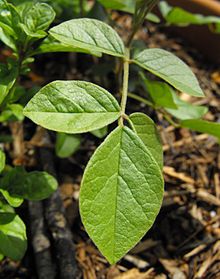- Glycyrrhiza uralensis
-
Not to be confused with Liquorice, Glycyrrhiza glabra.
Glycyrrhiza uralensis 
Scientific classification Kingdom: Plantae (unranked): Angiosperms (unranked): Eudicots (unranked): Rosids Order: Fabales Family: Fabaceae Genus: Glycyrrhiza Species: G. uralensis Binomial name Glycyrrhiza uralensis
Fisch.[1]Synonyms Glycyrrhiza asperrima var. desertorum Regel
Glycyrrhiza asperrima var. uralensis Regel
Glycyrrhiza glandulifera Ledeb.[2]Glycyrrhiza uralensis, also known as Chinese liquorice,[3] is a flowering plant native to Asia, which is used in traditional Chinese medicine.
Contents
Medicinal uses
Liquorice root, or 'radix glycyrrhizae', is one of the 50 fundamental herbs used in traditional Chinese medicine, where it has the name gān cǎo (Chinese: 甘草)[1]. It is usually collected in spring and autumn, when it is removed from the rootlet and dried in the sun. Liquorice root is most commonly produced in the Shanxi, Gansu and Xinjiang regions of China.[4]
As well as traditional Chinese medicine, Liquorice root is used in Greco-Arab and Unani medicines, as well as in the traditional medicines of Japan, Korea, Vietnam, Pakistan, India and other Asian nations[citation needed]. Its Arabic name is 'Asal-as-Soos' and in Pakistan / India it is referred as 'Mulethi'. The Greco-Arab (Unani) Medicine recommend its oral use after removal of external layer to avoid side effects. People with heart conditions or high blood pressure should avoid ingesting extensive amounts of liquorice, as it can further heighten blood pressure and lead to stroke.
A Chinese legend tells how liquorice root first came to be used in traditional Chinese medicine:
A long time ago, there was an old doctor with excellent medicine skills. He opened his medical office in his home with a few students as assistants. One time, he had to leave home for a couple of days, and before the old doctor left, he gave his students several drug packages in order for them to help out with the home patients. The old doctor did not return home on time, and the medicine he left for his students were running out, and there were still many patients to cure. In the backyard, however, there were some chopped and dried grasses used for boiling the water left, so the students administered them to the patients and told them that it was their teacher’s medicine. Magically, the patients who were suffering from spleen and stomach problems, coughing phlegm, or with sore throats and ulcers were cured from this medicine. These dried grasses were liquorice roots. Since then, liquorice roots have been widely used in Chinese medicine and healing.[citation needed]
Usage
There are several ways of using liquorice root in Chinese therapy. liquorice root could help enhance the transformation and transportation functions of the spleen and stomach. Since the spleen dominates muscles and the liver controls tendons, liquorice root has excellent properties to relieve pain and cramps of smooth or skeletal muscles.[citation needed] liquorice root also moistens the lungs and stops coughs. It treats disorders such as shortness of breath, fatigue, sallow facial appearance, decreased food intake, loose stools, and diarrhea. Its neutral property treats coughing and wheezing of various etiologies that stems from either cold or heat, and deficiencies of excess, with or without phlegm. liquorice root can also be used to clear heat and toxins; it is useful to treat poisoning due to foods, herbs, herbicides, pesticides, drugs and heavy metals.[5].Liquorice root has also been reported to speed the healing of canker sores.
Side effects
Liquorice root contains glycyrrhizin, which can cause high blood pressure, salt and water retention, and low potassium levels; it could also lead to heart problems. Patients who take liquorice with diuretics or medicines that reduce the body’s potassium levels could induce even lower potassium levels. Taking large amounts of liquorice root could also affect cortisol (a body level’s hormone) levels as well. People with heart disease or high blood pressure should be cautious about taking liquorice root. Pregnant women also need to avoid liquorice root because it could increase the risk of preterm labor.[6]
See also
- Chinese herbology 50 fundamental herbs
- Liquorice
References
- ^ a b "Glycyrrhiza uralensis - Plants For A Future database report". http://www.pfaf.org/database/plants.php?Glycyrrhiza+uralensis. Retrieved 2008-02-08.
- ^ "Catalogue of Life : 2010 Annual Checklist : Glycyrrhiza uralensis Fisch.". http://www.catalogueoflife.org/annual-checklist/2010/details/species/id/584444. Retrieved 2010-07-10.
- ^ "Glycyrrhiza uralensis information from NPGS/GRIN". Germplasm Resources Information Network. United States Department of Agriculture. http://www.ars-grin.gov/cgi-bin/npgs/html/taxon.pl?17824. Retrieved 30 August 2011.
- ^ “Gan Cao.” Chinese Medical Herbology and Pharmacology. http://www.aompress.com/book_herbology/pdfs/GanCao.pdf. 25 April 2010.
- ^ “Radix Glycyrrhizae”. Science Medicinal Plants. http://www.islamset.com/sc/plants/glycyrr.html. 25 April 2010
- ^ "liquorice Root". National Ceneter for Complementary and Alternative Medicine. http://nccam.nih.gov/health/liquoriceroot/. 25 April 2010.
External links
Categories:- Plants used in Traditional Chinese medicine
- Ayurvedic medicaments
- Traditional medicine
- Faboideae
Wikimedia Foundation. 2010.
